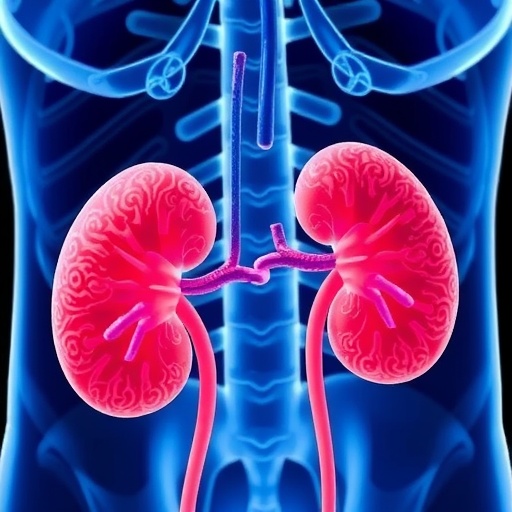In a groundbreaking study that delves into the intricate relationship between metabolic processes and chronic health conditions, researchers have identified a significant mediator in the nexus connecting serum uric acid levels, glucose disposal rates, and chronic kidney disease (CKD) among patients grappling with diabetes or prediabetes. This research, based on robust data from the National Health and Nutrition Examination Survey (NHANES) spanning from 2005 to 2018, reveals crucial insights that could potentially reshape our understanding of metabolic dysfunctions and their implications for kidney health.
The study spearheaded by an international team of investigators, including notable researchers Yin, Luo, and Fu, underscores the understudied yet critical role of serum uric acid. Traditionally viewed as a mere byproduct of purine metabolism, uric acid has now emerged as a significant player in metabolic regulation, with this research providing a vital link between elevated levels of uric acid and serious health conditions such as CKD.
Chronic kidney disease, a complex and progressive ailment, has long been associated with various metabolic disorders, most notably diabetes and prediabetes. With diabetes rates reaching alarming levels worldwide, understanding the contributing factors to CKD in these populations is of utmost importance. The findings from this analysis demonstrate how elevated serum uric acid levels can exacerbate the challenges faced by both diabetic and prediabetic patients, ultimately leading to deteriorating kidney function.
The researchers utilized data drawn from the NHANES database, which offers a comprehensive snapshot of the American population’s health metrics. By meticulously analyzing this data, researchers were able to ascertain not only baseline uric acid levels but also their association with the estimated glucose disposal rate – a critical measure of how effectively the body utilizes glucose. This analysis yielded compelling evidence that suggests changes in glucose metabolism may be directly influenced by fluctuations in serum uric acid levels, indicating a potential pathophysiological mechanism at play.
The implications of these findings extend beyond theoretical understanding; they present tangible clinical considerations for practitioners managing diabetes and prediabetes in their patients. The potential for serum uric acid to serve as a predictive biomarker for CKD development could revolutionize how healthcare providers approach treatment and prevention strategies in these vulnerable populations. By identifying patients at higher risk due to elevated uric acid levels, clinicians can tailor interventions more effectively, potentially reversing or mitigating the progression of kidney disease.
Moreover, the insight that serum uric acid may act as a mediator reinforces the importance of holistic patient management. It sheds light on the necessity of monitoring not just blood glucose levels, but also uric acid concentrations in diabetic or prediabetic individuals. This highlights a paradigm shift towards comprehensive metabolic health assessments which could facilitate timely interventions that might prevent or at least postpone the onset of chronic kidney disease.
The researchers also emphasized the need for further studies to dissect the cellular mechanisms underpinning the association between uric acid and glucose metabolism. Unraveling these pathways may open new avenues for therapeutic interventions targeting uric acid levels to improve metabolic health and protect kidney function. As metabolic syndrome becomes increasingly prevalent, understanding the systemic effects of uric acid could be pivotal in public health efforts aimed at curbing chronic disease incidence.
In conjunction with existing literature, these findings call for a reevaluation of dietary guidelines and lifestyle recommendations for patients with high uric acid levels. The negative implications of excess uric acid extend beyond renals; it has been associated with increased inflammation and cardiovascular risks, posing additional concerns for patients with diabetes. As such, integrating dietary strategies that limit purine intake while promoting kidney health could be vital components of management plans.
The study’s conclusions also serve as a warning about the dangers of overlooking biomarkers such as serum uric acid in clinical practice. The robust correlation established between uric acid and the risk of CKD illustrates the need for increased awareness and education among healthcare providers. As with many chronic conditions, early identification and intervention can significantly alter patient trajectories toward improved health outcomes.
The researchers have made this information publicly accessible, inviting broader discussions and further investigations into these critical relationships. The transparency surrounding their findings encourages multidisciplinary collaboration among epidemiologists, nephrologists, endocrinologists, and nutritionists to jointly tackle the challenge of chronic diseases like CKD.
In essence, this pivotal research contributes significantly to our understanding of metabolic health. It highlights the intricate web of interactions that define chronic kidney disease risk factors, urging healthcare professionals to adopt a more inclusive approach to diagnosis and treatment. As the understanding of serum uric acid’s role evolves, so too will the strategies employed in treating diabetes and its associated complications.
The pursuit of improved health outcomes for individuals with diabetes or prediabetes necessitates a commitment to evidence-based practice. With burgeoning evidence linking uric acid to glucose metabolism and kidney health, this research can serve as a foundation for future studies aimed at elucidating the complexities of these associations. More importantly, it emphasizes the ongoing need for vigilance and proactive health management to stave off the rising tide of chronic kidney disease.
As we navigate the intricate landscape of metabolic disorders, this research shines a light on a path forward. By recognizing and addressing the mediators of disease processes, including serum uric acid, healthcare teams can prioritize prevention and intervention protocols that holistically encompass patient health and wellbeing.
Medical professionals and researchers are called upon to heed this insight and reinforce their educational efforts regarding the management of chronic diseases. The exploration of novel interventions to manipulate uric acid levels, alongside lifestyle modifications, promises a compelling frontier in the fight against chronic kidney disease – a condition afflicting millions worldwide.
The journey does not end here. This groundbreaking study signifies the necessity for ongoing research and innovation as we strive for a healthier future. Engaging with patients about risk factors, such as uric acid levels and their implications, will be essential as we collectively aim to reduce the burden of chronic kidney disease associated with diabetes and prediabetes. Together, we can build a more informed and health-conscious society ready to take action against these preventable diseases.
Subject of Research: The role of serum uric acid in mediating the relationship between glucose disposal rates and chronic kidney disease in patients with diabetes or prediabetes.
Article Title: Serum uric acid mediates the association between the estimated glucose disposal rate and chronic kidney disease in patients with diabetes or prediabetes: an analysis from NHANES 2005–2018.
Article References:
Yin, J., Luo, M., Fu, Q. et al. Serum uric acid mediates the association between the estimated glucose disposal rate and chronic kidney disease in patients with diabetes or prediabetes: an analysis from NHANES 2005–2018.
BMC Endocr Disord 25, 262 (2025). https://doi.org/10.1186/s12902-025-02081-1
Image Credits: AI Generated
DOI: https://doi.org/10.1186/s12902-025-02081-1
Keywords: serum uric acid, chronic kidney disease, diabetes, prediabetes, glucose disposal rate, NHANES 2005–2018.
Tags: chronic health conditions and uric acidchronic kidney disease risk factorsdiabetes and uric acid relationshipelevated uric acid and health conditionsglucose disposal and chronic kidney diseaseinternational research on metabolic regulationmetabolic dysfunction and health implicationsmetabolic processes in kidney diseaseNHANES study on uric acidprediabetes and kidney healthrole of uric acid in metabolismuric acid and kidney disease





